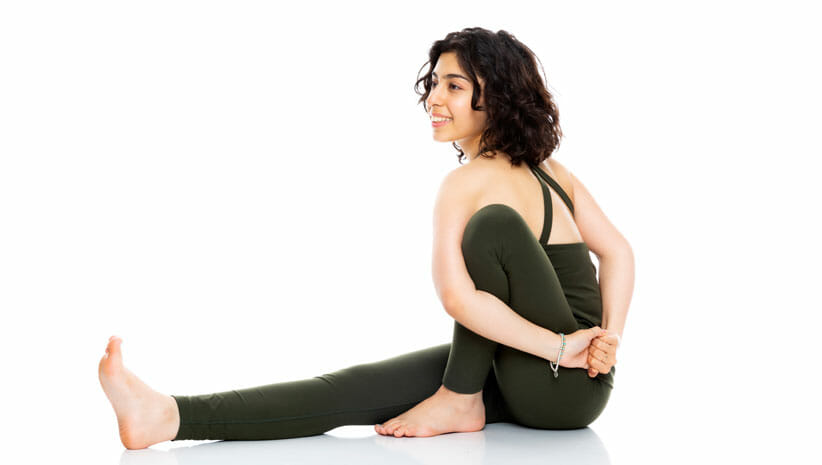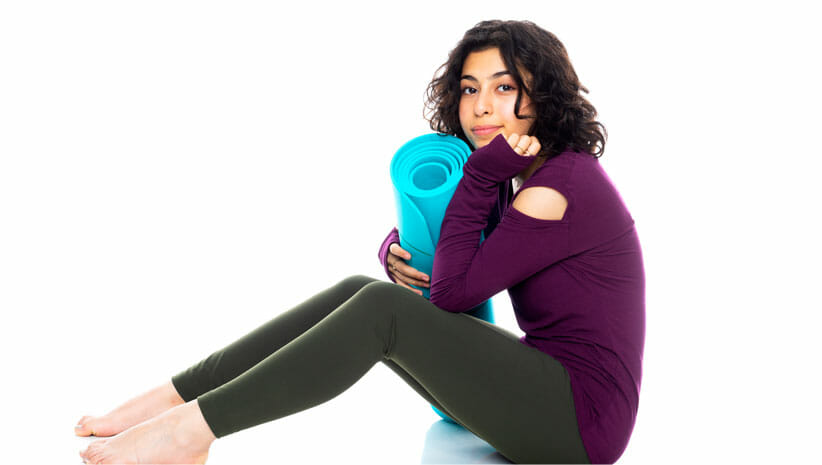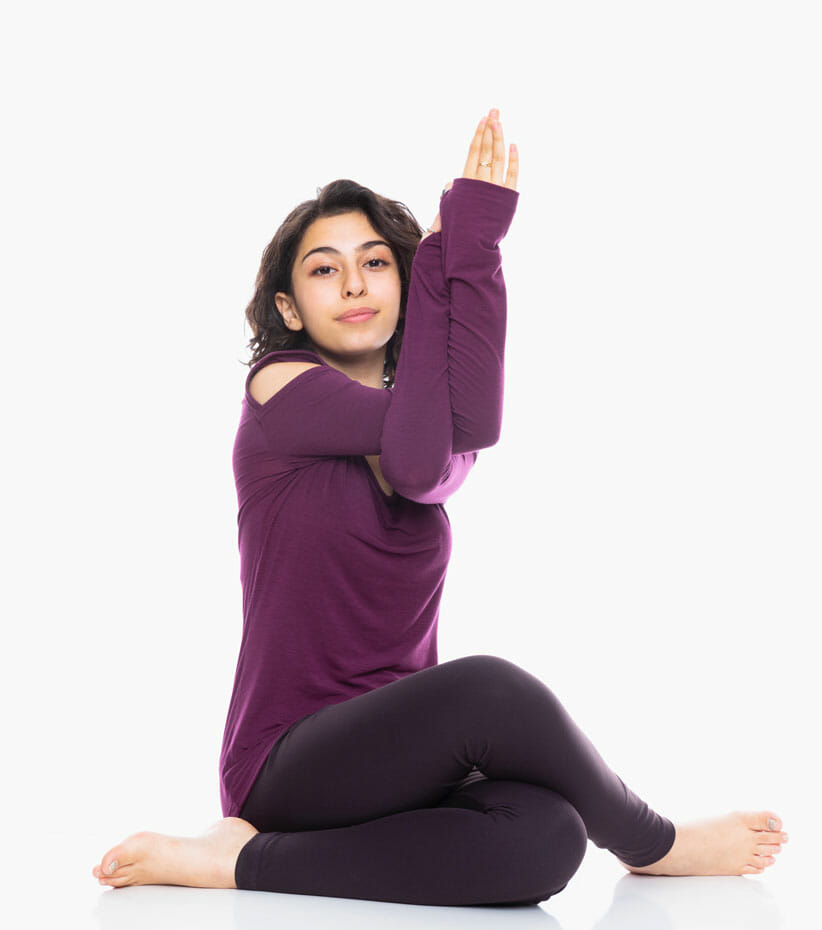
Natalie Asatryan photo by David Young-Wolff. Clothing by KiraGrace.
How Yoga Supports Success When Going Back to School or Back to Work
We’re entering the change in seasons from Summer Vacay (hours of binging Netflix Originals, poolside days, and mid-week beach escapes) to Back to School or Back to Work. Just thinking about schedules, test-taking, studying, homework, exams, and added responsibilities may be stressing you out. I find that the tools of yoga and meditation can be most important practices to reduce stress and enjoy success. From attitude adjustments to breathing to increased focus and poses for tension relief, and techniques to reduce stress, here are some of my go-to Back to School Supplies.
1. Attend to Your Attitude
First, if you’re dreading the days in the classroom or at your desk, take a look at your attitude. We can change our negative outlook l from, “I have to go to school” to “I get to go to school.” We can apply this change of attitude to just about anything that we might usually meet with mixed feelings.
When it comes to school, I think it is important to remember that there are so many kids around the world who don’t have the opportunity to go to school—and would do anything to receive an education. In other words, shift your attention from dread to an attitude of feeling grateful for the gift of an education.
2. Set an Intention for Success
Setting intentions can help you have a fun and productive year. If you keep repeating to yourself, “This year is gonna suck!” Then guess what? The year will suck because you walked in with that mindset. If you tell yourself, “This year will be great!” I bet you can figure out what will happen.
3. Just Say No to Toxic Relationships
Toxic relationships can weigh you down. Try setting the following intention, “There will be no toxic friendships for me in the school year of 2019-2020.” Manipulative friendships distract your attention and increase your stress level. Having to constantly please and take care of a “friend” will drain your energy.
4. Cultivate Your Inner Confidence to Reduce Stress
Walk into each and every room with an air of confidence. Now, I don’t mean arrogance. There is a difference. You can be confident and still be humble. After all, arrogance can lead to bypassing the work that needs to be done to experience success. A healthy degree of humility inspires us to study for that upcoming math test and then walk in the room with the confidence that comes from preparation. If math isn’t your strongest subject and you have a test tomorrow? Great! Study your butt off and walk in knowing that you’re prepared.
Confidence is connected to perseverance. Recently, I just could not learn some choreography while I was in dance camp. Instead of feeling frustrated for being a “bad dancer,” I kept practicing with confidence. I told myself that I could do it. Every time I fell, I got up and tried again. I knew that I was there to learn. If I knew everything there is to know about dancing, I wouldn’t need to be at a dance camp. The confident, humble person knows that they do not already know everything. Eventually, my perseverance paid off.
Believe in yourself. Walk around like you’re the coolest person you know and soon you will start to believe it. Pay attention to how you speak about yourself and if you’re speaking negatively about yourself. If you keep saying you’re a terrible soccer player and that you don’t deserve to be on the team, you may start to believe it. Cultivate confidence with the opposite thoughts. If you say that you’re amazing, you will begin to believe it. And then you will begin to be it!
Cultivating Confidence in the Yoga Sutras
This is described in Patanjali’s Yoga Sutra, which is one of the books outlining the psychology of yoga. Sutra 2.33 talks about this practice of shifting our thoughts. Patanjali says that when we are feeling negative, we can cultivate the opposite thought or feeling. The Sanskrit term for this is pratipaksha-bhavana. Boost yourself up and cultivate your confidence! Cultivating the opposite of the negative is a yoga practice that is more important than perfecting your handstand.

Natalie Asatryan photo by David Young-Wolff
5. Studying Works!
Going along with cultivating confidence and having the humility required for preparation, success comes when we put the time in. So: Study, study, study! Remember the confidence that comes with preparation? Yep! It works! Preparation helps reduce stress. But studying is also hard. It requires focus!
6. Focus
If you’re like me, you’ve grown up in a world with some form of media always on in the background. That can be the TV playing, podcasts, the radio. or your phone. There are those times when you’re “watching” TV but also on your phone. We’ve all grown up with short attention spans and that can make it hard for us to focus on one subject long enough to actually take in any information. We all know that “studying with Netflix playing in the background” doesn’t actually work. And if you somehow haven’t tried that yet, take it from me (a person with experience) that it doesn’t work out well.
Try removing some of your habitual distractions. The yoga practice for this is called pratyahara. This refers to directing our attention away from everything going on outside of ourselves to what is going on inside of ourselves. This can include study.
We can set incremental goals to help build our focus. For example, if you know it’s hard for you to focus on something for more than 20 minutes, decide to read for 15 minutes. Then slowly move the time up until you’re ok with reading for 45 minutes. Remember to take regular breaks to reduce stress.

Natalie Asatryan photo by David Young-Wolff.
7. Schedule Brain Breaks
If you’re going to be doing your science project all night, then give yourself a five-minute break every half an hour to keep yourself from getting mentally tired. But careful to not give yourself too many breaks. You could end up working for just five minutes then taking a five-minute break and that is no way to get anything done.

Natalie Asatryan photo by David Young-Wolff. Clothing by KiraGrace. Yoga Mat by The Guru Grid.
8. Time Block Your Day to Reduce Stres
Grab a planner or a notepad and time block your tasks. Give yourself set times for each assignment.
Here’s an example of something that worked for me:
3:00 – get home
3:00 – 3:30 – rest
3:30 – 3:55 – math homework
4:00 – 4:55 – science project
4:55 – 5:05 – stretch break
5:05 – 5:30 – reading for English
5:30 – 6:00 – dinner
6:00 – 6:25 – math homework
6:30 – 7:00 – science project
In this example, I also split up some of my challenging tasks into multiple sessions. Doing this can help keep you from experiencing burnout. Coming back to a task after some time away allows you to see it with fresh eyes. For example, maybe you memorize all of your vocabulary for history class for half an hour, and then switch to completing homework for another class, then you come back and see how much you remember from the history lesson and what you still need help to master.
9. Plan Some Play
Success at work or school is important, but not more than your own health. Give yourself some me-time everyday. Make sure to eat healthy dinners and breakfasts. Don’t compromise on your sleep just to get work done. And make sure to get some exercise and do some yoga, too! Chase the dog. Pet your cat. Spend some time outside. Go to the movies. Hang with friends. Balance work and play.
10. Strike a Pose: 5 Poses to Reduce Stress

Natalie Asatryan photo by David Young-Wolff. Clothing by KiraGrace.
Seated Twist
Twists are great for stress relief especially in places like at a desk in school where you wouldn’t want to draw too much attention. Sit with your feet flat on the floor in front of you. Twist your body to the right by reaching for the back of your chair with your right hand and placing your left hand on your right knee. Allow your head to be in a relaxed position. Take a few deep breaths. Release and then repeat this on the other side.
Floor Twists
You can also practice a number of different varieties of twits on the floor, either while seated with one leg outstretched and one knee bent. Turn toward your bent knee and hug your knee in to your chest or wrap your arms around your bent knee. Take a few deep breaths and then switch sides.
If you’re at home, and can lay down on your mat, I recommend a twist on the floor. Find a comfortable position on your back and hug your right knee into your chest. Rotate so that bent knee rotates to the left. If it’s comfortable, turn your head to the right. Take a few deep breathes and then switch sides. This can be a great unwinding pose if you’ve been sitting at a desk all day or slouched over a computer screen.

Natalie Asatryan demonstrating eagle arms. Photo by David Young-Wolff. Clothing by KiraGrace.
Eagle Arms
I find this one helpful since I tend to hold a lot of tension in my shoulders. Begin by reaching your arms out in front of you and then bend your elbows. Cross your right arm over your left arm and wrap your wrists around each other and press your palms together. If your palms do not touch, you can press the back of your hands together. If you are unable to touch your hands, keep your elbows crossed and touch your hands to the opposite shoulder. Pull your arms up and away from your chest. Take a few deep breaths, enjoy the stretch, and then switch.

Natalie Asatryan photographed by David Young-Wolff. Clothing by KiraGrace.
Pigeon
I love the way pigeon pose counterbalances sitting in a chair and creates the completely opposite shape. I find that doing this pose at the end of the day helps release some of the stress of sitting. Start by sitting, on your hands and knees, or in downward facing dog. Bend your right knee by rotating your right hip. Your shin may be parallel to the front of the mat, your foot may be tucked into your body, or anywhere in between. Reach your left leg out on the floor behind you. In this pose, you have the option to bend your elbows on the floor and rest your head in your hands. You could also use your arms for support and lift your upper body for a supported backbend. Take a few deep breaths, carefully come out of the pose, and practice the other side.
If this pose is not supportive for your knees, then practice pigeon on your back instead. Start out with both knees bent and the soles of both feet on the floor. Take your right ankle to the top of your left thigh. Stay here, or lift up your legs and draw them toward your chest. Gently hold your legs. Take several deep breaths and then switch sides.
11. Three Yogic Tools to Reduce Stress and Test Anxiety
One of the back-to-the-real-world events we dread, no matter our age, is test taking. I get it, tests are hard. I can study for hours and get a 100% on homework assignments and study guides, but when the teacher passes out the tests, I get nervous. More nerves = lower test score. Here are some remedies to reduce stress:
1. Stay Calm and Take the Test
My first tip is deceptively simple: Don’t freak out. While tests are important, freaking out leads to extra stress and stress makes everything harder. So if you don’t want your test to be harder than it already is, do what you can to calm down. My favorite method of test-taking stress reduction is the breathe.
2. Breathe! It Takes 20 Seconds to Tell Yourself, “I’ve Got This!”
Try breathing with intention before, during, and after a test. It’s simple and it works. It’s a meditative practice that helps improve focus and reduces stress. You can do this anywhere, anytime. I don’t mean to sit in your math class with your legs in lotus and chant “Om.” I mean, if your teacher lets you do that, go for it! That sounds really cool, actually. Otherwise, sit and slowly breathe in and out for about 20 seconds while telling yourself “I got this.”
3. Count Your Breaths to Reduce Stress
This breath practice sends a message to your body to relax. The amazing thing about breathwork is that it can both calm and energize the body. At your desk, you can use a variation of this breath counting practice.
Inhale for 4 counts.
Hold for 2 counts.
Exhale for 6 counts.
Hold for 2 counts.
Putting Practice into Practice
Enjoy your time at your desk. You get to do this! Remember that everything begins with your attitude. Then continue the good work set up by your attitude with discipline. Make choices that allow you to experience success.
Natalie Asatryan is the youngest certified female yoga teacher in America. Through her teaching, she is focused on using the power of yoga and mindfulness to create positive change in the world.
